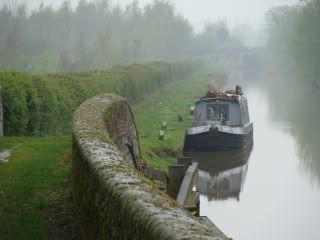Oxford Floating Chapel..
http://news.bbc.co.uk/local/oxford/hi/people_and_places/nature/newsid_8453000/8453605.stm
I came across this today, I think it is fascinating.
Here it is cut and pasted:
Oxford Boatmen's Floating Chapel
By Mark Davies
Local historian and walks' guide
![]()

The chapel used to be moored north of Hythe Bridge
Blessed are those who sow beside all waters.
For nearly thirty years of the 19th century, anyone glancing north from Hythe Bridge in Oxford would have noticed a curious wooden structure.
Next to the Oxford Canal on the branch of the Thames called the Castle Mill Stream was a converted river barge.
This was a floating chapel provided largely through the benevolence of a local coalmerchant and boatbuilder, Henry Ward (c.1781-1852).
The Chapel was consecrated by the Bishop of Oxford on 29 December 1839. It was 70 feet long by 14 feet wide, and capable of accommodating 150 people.
The weekly newspaper Jackson's Oxford Journal called it "a very pretty floating chapel in the Egyptian style" and commented on its "chaste and elegant design … judiciously decorated with appropriate ornaments".
The paper also noted that "at one end is a small room, to serve the purpose of a vestry room, and at the other a space is allotted for the person taking care of the chapel to reside in".
The Chapel had a dual purpose: providing a Sunday service for what the Bishop described as "that neglected and too often depraved class, the boatmen on your canals" and as a school for their children.
In the early years, according to the Chapel's published accounts, between 50 and 70 pupils attended, rising to over 100 in the 1850s, by which time the school was operating daily, and admitting in addition local children who were not from the boats.
Most of them probably came from of St. Thomas' parish, where many members of Oxford's extended traditional boating families resided.
The Chapel was considered sufficiently permanent to be named on Robert Hoggar's 1850 map of Oxford, and the Oxford photographer Henry Taunt wrote that "at one time it was quite fashionable to attend the services, and we have seen the place crowded".
The Chapel's trustees were honest about their true effectiveness, however, conceding that "ministering to a body of men who have no settled homes is a work of which the fruits can of necessity only very imperfectly be ascertained".
They were nonetheless confident that "the very appearance of a Chapel, set apart to the special necessities of the Boatman and his Family, must be a witness that they are no longer the neglected class they once were, with no man caring for their souls".
This subtle means of gaining the trust of the suspicious and insular boating community was commented on by G. A. Simcox of Queen's College, who recalled in 1874 the "ingenious floating chapel moored near Oxford, that almost solved the problem of looking like a barge and a church at once (it was made of wood, and cruciform)".
He also referred to "a neatly glazed and framed placard in the vestibule: 'No pipes to be lighted till the text is given out' ". This was an allusion to what was considered to be the universal nicotine habit of boatmen of the time.
The cost of maintaining the Chapel was always a concern for the trustees, though the main expense was not for the upkeep of the vessel itself but for the chaplain's salary, and to a lesser extent that of the schoolmistress (who is sadly never named).
Income came from donations by well-wishers and a collection made once a year at an special service at one of several churches in the city (St. Thomas, St. Martins, Carfax, St. Paul's, St. Mary Magdalen, St. Giles, St. Michaels, Holywell, and All Saints).

The floating chapel was a converted river barge.
Notable benefactors were the Oxford Canal Company, which made a consistently large annual contribution, and Christ Church, as the college responsible for St. Thomas', the parish in which the Chapel lay.
Some other regular donors are prominent names in Oxford still: F. J. Morell, Thomas Mallam, Mr. Gill, and Messrs. Gill & Ward (the ironmongers).
The Ward of 'Gill & Ward' was one of the sons of Henry Ward, the philanthropist who was responsible for the original idea of the Chapel.
Henry Ward is as good an example as any in Oxford of the opportunities the industrial revolution provided for social mobility. His father William (c1755-1815) had been one of the original coalmerchants operating from the terminal basin of the Oxford Canal (now Worcester Street carpark) when the first boats were admitted on New Year's Day 1790.
William had probably been a boatman in his earlier life, and after his death, Henry (described with surprising candour in William's will as his "natural born and adopted" son, born at the small canalside village of Hillmorton in Warwickshire) expanded the scope of the family firm.
By the 1830s, as well as the mainstay of coal, he was trading in corn, malt, slate, seed, and salt, and also built canalboats in Jericho from at least 1819.
Henry Ward's eldest son William (1807-1889) continued to guide the family fortunes, and was elected Mayor of Oxford on two occasions. The family were also highly active nationally in restricting Sunday trading on the canals, and demonstrated their continuing spiritual concern by donating the land for Jericho's St. Barnabas' Church in 1868.
This was the same year - and it is probably no coincidence - that the Chapel ceased to function. The Rev. A. B. Simeon summarised the event in his tribute to Thomas Chamberlain, the long-serving (1842 until 1892) vicar of St. Thomas' parish: "Being possessed of less endurance than the Vicar, and probably weary and disgusted with its poor surroundings, it quietly sank one Sunday morning. It was not worth raising."
Henry Taunt put a more positive spin on the situation, saying that the Chapel had "fulfilled her mission". It was replaced, with Thomas Chamberlain's backing, by a permanent building on Hythe Bridge Street, which doubled as a day school for infants and a night school for the men. Services were held in the building until about 1892. It is now the 'Bangkok House' Thai restaurant.




7 Comments:
Hi Bones.
I came across some records of boaters missions in and around Birmingham recently:
http://captainahabswaterytales.blogspot.com/2009/11/boatmans-missions-on-canals-of.html
The photo of the narrowboat classroom comes from Braunston I think, but there was something similar in Wolverhampton for a while.
Andy
Coo - now there's an idea for your Pa when he retires :=)
good grief! Miss T please no ideas in Pa's head for now.
Free2live
Mark Davies and Catherine Robinsons book “ATowpath Walk in Oxford” has lots of fascinating info. I got mine in Waterstones but it is sometimes displayed outside Marks boat on the Hythe Bridge Arm (not sure of the name – the book says it is No 12)
The Oxfordshire County Council website has lots of old photos, including the chapel one. I can’t do a direct link. Try the Library and Heritage link then search for “oxford canal”.
Not sure about the niceties of copyright on these old photos.
Father Pugwash?
There's now a floating church in Docklands: St. Peter's Barge at West India Quay. Info here: http://www.stpetersbarge.org/
Did you see my comment in reply to yours pn SONFLOWER'S LOG?
I repeat it her 'cos I dn't know how the communication works.
"YES Bones, BCF work in association with Canal Ministries who have currently EIGHT boat with ful time missioners. They are not all what one would think of as a vicar because most of them are continuously cruising. They do tend to have a favourite patch on the system and get a little 'flock' of boaters especially in winter on winter moorings etc.
We only know of one floating church. We are visiting it next Thursday, 28th. Want to come? http://www.canalministries.org.uk/ "
Post a Comment
Subscribe to Post Comments [Atom]
<< Home